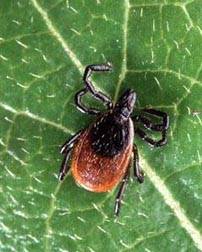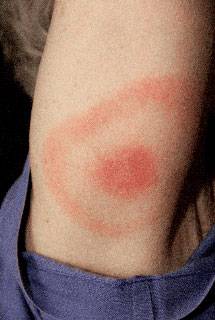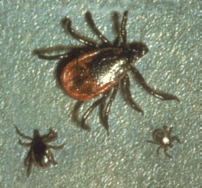Lyme Disease
|  | | TheBorrelia burgdorferispirochete is the agent of Lyme disease. Photo by CDC |
|
| |  | | The deer tick,Ixodes scapularisis the main carrier of theBorrelia burgdorferi. Photo by USDA. |
|
|
While the infection we know today as Lyme disease (named for the Connecticut town of Lyme) has been around for at least a century, public awareness and confusion did not really occur until the late 1980s. Media exposure of this infection virtually exploded, leaving most of the general public with some basic knowledge and a great deal of misconception. We hope to straighten out some of the myths surrounding at least the canine version of the Lyme disease infection. Human Lyme Disease vs. Canine Lyme Disease |  | | TheErythema migransis the characteristic skin rash shown by humans shortly afterBorrelia burgdorferiinfection. Dogs do not exhibit a similar rash with Lyme disease. Photo by CDC. |
|
The first lesson about the Lyme disease infection is that it manifests completely differently in man's best friend compared with the human experience. After being bitten by a tick that has transmittedBorrelia burgdorferi, 80 percentof humans will develop a rash and/or flu-like symptoms.In the next few weeks, joint pain ensues with15 percentof people developing neurologic abnormalities associated with Lyme disease andfive percentof people developing a heart rhythm disturbance called A-V block. At this same point in the infection timeline, dogs have yet to develop any symptoms at all. Weeks to months after infection, about 60 percentof people will experience intermittent arthritis attacks andfive percentwill develop chronic neurologic manifestations. In humans, Lyme disease has the potential for serious long-term illness. In dogs, illness may never even occur. When canine illness does occur, it does not begin to manifest for weeks to months after infection at which point arthritis signs are noticed. Sometimes there is a fever. In dogs, heart and neurologic issues are exceedingly rare, plus the symptoms of canine Lyme disease generally respond rapidly to an inexpensive course of proper antibiotics (see below for details). TheBorrelia burgdorferiorganism is fairly well suited to live in the canine body without causing trouble. Most exposed dogs harbor the organism uneventfully and never get sick. Still, it is important not to discount Lyme disease in dogs completely lest you overlook an easily eliminated cause of chronic joint disease, especially in dogs of the Northeast U.S. A dog’s most serious long-term potential regards glomerular disease. This is a type of kidney damage that occurs when the immune system is stimulated over a long time by a latent infectious organism or other immune stimulus. This is a much more insidious problem for which specific testing is needed (see below). The Tick and Its Control An organism that serves to transport and deliver an infectious organism from one host to another is called a vector. The vector of Lyme disease in the Northeastern United States is the deer tick,Ixodes scapularis. The female tick lays a clump of approximately 2,000 eggs in the spring. A small six-legged larva hatches and attaches to a host as soon as it is able. Since the larva is small, it typically can only reach a small host, usually a white-footed mouse. If the mouse is carrying the Lyme disease spirochete, the larva can get infected at this point.
|  | | Three stages of the deer tick: The larva (bottom right), nymph (bottom left), and adult female (top). Photo by CDC |
|
When the larva is full of blood, it will drop off the host and lie dormant until the following spring, about a year later. At this point the larva molts and becomes a nymph. The nymph is a bit larger and may select another mouse as host or may approach larger game such as a dog or human. The nymph feeds three to five days and when it is full it drops off and remains dormant until late summer. It then molts into an adult tick. When the nymph is feeding, it may infect its host with the Lyme spirochete. If the nymph was not already infected from its larval stage, it may become infected now during its spring feeding. The adult tick seeks a larger host, hence its name the deer tick; however, with man encroaching upon the range of the deer, there are often plenty of dogs or humans for the tick to attack. The adult ticks mate on their new host, feed, and transmit the Lyme spirochete if they are carrying it. The male tick remains attached through the winter but the female, once engorged with the host’s blood, drops off, hides under leaves and other debris through the winter, and in springlays her eggs for the two-year cycle to begin again. The adult tick seeks a larger host, hence its name the deer tick. However, the feeding tick is basically a blood-sucker. It must keep its host’s blood from clotting in order to continue sucking so it is able to regurgitate assorted enzymes to keep the blood flow liquid and smooth. It is during this regurgitation process that the Lyme spirochete is brought up from the tick’s mid-gut to its mouthparts. This process requires a minimum of 48 hours, which means that if the tick is removed within 48 hoursafter attaching, the spirochete cannot be transmitted and the host will not get the disease. Tick control on the host is an effective means of preventing infection. There are numerous effective tick control products available in assorted formats including chewable treats, collars, and topical spot-on treatments. All of theseproductseither kill the tick or cause it to drop off prior to the 48-hour deadline. On the west coast of the United States, there is far less Lyme disease than in the east, although the northern coast of California is considered to have moderate risk. This is because the Lyme vector in these areas is primarily Ixodes pacificus, a tick that strongly prefers to feed on reptiles rather than mammals. Reptile blood has natural anti-Borreliafactors which kill the Lyme spirochete and prevent further transmission.
Acolor-coded mapsearchable by zip code can show the prevalence of Lyme disease in any U.S. area. There are several subspecies ofBorrelia burgdorferiin different parts of the world, so Lyme disease is not unique to the United States. Borrelia burgdorferi: The Spirochete and Its Detection The spirochete that causes Lyme disease cannot live outside the body of a host. It must live within either a mammal or a tick. In the mammal’s body, the spirochete is especially adept at binding to connective tissue. If you are doing additional reading on this organism, you will encounter references to the spirochete’s surface proteins called Osp (Osp stands for outer surface protein). Different Osps are expressed depending on whether the spirochete is attached to the tick midgut (OspA, OspB, and OspD) orthe mammal’s connective tissue (OspC).By modifying its Osps, the spirochete is able to change its presentation to the mammalian host’s immune system thus escaping immune destruction. In addition to changing Osps, the spirochete is able to change its presentation to the mammalian host’s immune system, thus escaping immune destruction. In addition to changing Osps, the spirochete can change its shape into at leastthree different forms and is able to hide within cellular folds. The Lyme spirochete is a master of disguise and camouflage. This camouflage presents an enormous diagnostic challenge: if the host's immune system can't even find the organism, how are we supposed to detect it? Antibody Levels A dog with symptoms of Lyme disease ideally should have a test to confirm or rule out Lyme disease. Since it is almost impossible to culture the Lyme spirochete, efforts have centered on detection of antibodies against the Osps. The problems encountered with this method are: - In a Lyme endemic area, as many as 90% of the dogs will have antibodies against the Lyme spirochete. Most exposed dogs never get sick but almost all of them will develop antibodies and these antibodies persist for years. How do we tell the dogs that have active infection from those that have been exposed and are not sick from their exposure?
- Vaccine has been available for Lyme disease for a decade or more. How do we distinguish antibodies generated by the vaccine from those generated by natural infection?
- How do we distinguish antibodies generated by similar organisms (Leptospira,for example, or harmless otherBorreliaspecies)?
The solution to these problems has come about only recently in the form of the C6 test. This is an immunological test for antibody against the C6 peptide, a unique section of the one of theBorrelia burgdorferisurface antigens. As the spirochete changes its configuration to escape the host's immune system, the C6 peptide remains constant and always detectable. Vaccine does not contain the C6 peptide so vaccinated dogs will not test positive. Dogs with other infections will not erroneously test positive. Furthermore, this test is simple enough to be available as an in-house test kitthat can be run in most veterinary hospitals with results in approximately 10 minutes. This still does not address distinguishing active infection from exposure. Dogs will test C6 positive within tothree to fiveweeks of infection. They stay positive for over a year. Treatment and Its Goals Which of these dogs get sick and which do not? Does the dog with joint pain, fever, and a positive C6 test need medication? This is where the news is particularly good. Treatment of Lyme disease utilizes atwo to fourweek course ofdoxycyclineor its cousin minocycline.Amoxicillincan also be used as an effective alternative. If Lyme disease is a consideration, many veterinarians simply prescribe the medication. Obvious improvement is seen within 48 hours. Furthermore, most tick-borne infections capable of causing joint pain, fever, and signs similar to Lyme disease generally all respond to doxycycline so a simple course of medication actually covers several types of infection. Eradication of the Lyme spirochete is not a reasonable expectation with treatment; the organism is simply too good at hiding. The goal instead is to bring the patient into what is called a premunitive state. This is the state that 90% of infected dogs achieve when they get infected but never get ill: the organism is in their bodies latently but is not causing active infection. Glomerular Disease Some dogs are in fact harmed by the long-term presence of an infectious organism in their bodies. The immune system is constantly active in its attempt to remove the invading spirochete, and over the years these complexes of antibodies may deposit in the kidney and cause damage. It has been recommended that dogs with positiveBorrelia burgdorferiantibody levels be regularly screened for significant protein loss in their urine with a test called a urine protein to creatinine ratio. This group of dogs may require medication for their kidney disease. See more information onglomerular disease. Recently an especially sensitive test has been developed to detect minute quantities of blood proteins in the urine. This test, called the Erd test, is so sensitive that its use is not yet determined (i.e.,at what point is albumin loss in the kidney significant and under what circumstances might some albumin loss be normal and expected?). Vaccination: Yes or No? The object of vaccination is to prevent infection in dogs vaccinated before any exposure to Lyme spirochetes. This means it is only helpful for dogs not yet exposed such as puppies and dogs from non-endemic areas travelling to endemic areas. Annual boosters continue the vaccine-based immunity There are now three types of vaccine available. The killed whole spirochete vaccine uses intact dead spirochetes injected into the host. By using the entire spirochete, the host is exposed to parts of the organism that are not useful in immunization and may lead to vaccine reaction. The next type of vaccine is felt to be superior in preventing reactions and that is the recombinant vaccine. This vaccine generates antibodies specifically against OspA, the surface protein the spirochete uses to attach to its tick host. When the tick bites and sucks blood full of anti-OspA antibodies, the spirochete’s migration sequence is blocked and the spirochete is prevented from even exiting the tick. The vaccine utilizes DNA for OspA cloned into a harmless virus so that the entire Lyme spirochete is not used; only the OspA DNA is used. The third type of vaccine targets a protein called OspC as well as the surface protein OspA. The idea is that the OspC antibodies kill anyBorreliathat have not been de-activated by the OspA antibodies, theoretically providing enhanced protection. Vaccination against the Lyme organism remains controversial. Understand both sides of the argumentso you can decide if you want to use one. Argument Against Vaccination Lyme disease in dogs is an infection for which over 90% of infected dogs will never get sick and thefive to ten percentthat do get sick can be easily treated with a safe, inexpensive course of antibiotics. This situation would seem to indicate that vaccination is simply not worth the expense. There is no point in vaccinating a dog that has already been exposed and is already housing the organism. Dogs living in Lyme areas should be tested prior to vaccination to make sure it is worthwhile to vaccinate them. This is an additional expense for a vaccine that is of questionable necessity. Argument for Vaccination We vaccinate ourselves for the flu, an infection that is for most people more of a nuisance than alife-threatening event, and think nothing of it. Vaccination is about preventing infection; just because an illness is not life-threatening does not mean that we shouldn't prevent it with vaccine. Furthermore, in a non-endemic area, Lyme disease is not going to be a cause of arthritisthat most veterinarians will consider. Treatment is only simple if you perform the treatment, but in an area where there is little Lyme disease, this treatment may easily be omitted. Why not just prevent the infection outright from the beginning if the dog is going to travel to a tick endemic area?
If we allow our dogs to readily become infected with the Lyme organism, do they not become a potential source for human infection through their ticks? We try to minimize the deer and mice in our vicinity and we want to keep company with the family dog, but who wants a reservoir of Lyme spirochete in their home? As for the kidney disease, we do not know what spirochete antigens are implicated in this condition. The recombinant vaccine exposes the patient only to one spirochete antigen (OspA) and prevents introducing the spirochete into the mammal's body. Vaccination, at least with the recombinant vaccine, may prevent this syndrome.
When it comes to prevention, there is nothing controversial about tick control. It is crucial in Lyme endemic areas to use tick-controlling products. Lyme disease is a regional problem. For more guidance regarding this infection in your area, or areas where you will be traveling, see your veterinarian. Additional Links LymeInfo.com CDC AVMA Date Published: 12/6/2003 5:51:00 PM
Date Reviewed/Revised: 04/30/2015
Copyright 2015 - 2017 by the Veterinary Information Network, Inc. All rights reserved.
Permanent Link: http://www.VeterinaryPartner.com/Content.plx?P=A&A=1588
|